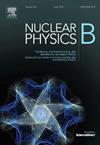Time evolution of the equation of state during perturbative reheating and its impact on the inflationary tensor perturbation spectrum
IF 2.8
3区 物理与天体物理
Q2 PHYSICS, PARTICLES & FIELDS
引用次数: 0
Abstract
The spectrum of inflationary tensor perturbations is one of the very few available probes of the post-inflationary reheating epoch, and it is strongly influenced by the Universe's equation of state during this period. In the current era of precision cosmology, an accurate estimation of this primordial tensor perturbation spectrum is crucial. Unlike the conventional assumption of a constant equation of state during the perturbative reheating phase, in this work we dynamically calculate the time evolution of the reheating equation of state for different values of the inflaton decay rates including their possible time-dependence in some cases. We further investigate its impact on the spectrum of primordial tensor perturbations, focusing on two different inflationary potentials of the E-model α-attractor class, with and . Using this approach, our results indicate that the inflationary tensor perturbations can be enhanced (or suppressed) by a factor of ∼1.5–3 compared to standard calculations assuming a constant inflaton equation of state. Such a variation arises because the evolution of the comoving horizon differs in the two approaches, causing different comoving momentum modes to re-enter the horizon at different times and undergo distinct evolutions.
微扰再加热过程中状态方程的时间演化及其对膨胀张量摄动谱的影响
暴胀张量摄动谱是后暴胀再加热时代为数不多的可用探测之一,它在这一时期受到宇宙状态方程的强烈影响。在当前精确宇宙学的时代,对这种原始张量摄动谱的准确估计是至关重要的。与传统的扰动再加热阶段状态方程不变的假设不同,在本研究中,我们动态地计算了不同膨胀衰减率值的再加热状态方程的时间演化,包括它们在某些情况下可能的时间依赖性。我们进一步研究了它对原始张量摄动谱的影响,重点研究了n=1和n=3时e模型α-吸引子类的两种不同的暴胀势。使用这种方法,我们的结果表明,与假设恒定的暴胀状态方程的标准计算相比,暴胀张量扰动可以被增强(或抑制)约1.5-3倍。这种变化是由于两种方法的共动视界的演化不同,导致不同的共动动量模式在不同的时间重新进入视界并经历不同的演化。
本文章由计算机程序翻译,如有差异,请以英文原文为准。
求助全文
约1分钟内获得全文
求助全文
来源期刊

Nuclear Physics B
物理-物理:粒子与场物理
CiteScore
5.50
自引率
7.10%
发文量
302
审稿时长
1 months
期刊介绍:
Nuclear Physics B focuses on the domain of high energy physics, quantum field theory, statistical systems, and mathematical physics, and includes four main sections: high energy physics - phenomenology, high energy physics - theory, high energy physics - experiment, and quantum field theory, statistical systems, and mathematical physics. The emphasis is on original research papers (Frontiers Articles or Full Length Articles), but Review Articles are also welcome.
 求助内容:
求助内容: 应助结果提醒方式:
应助结果提醒方式:


